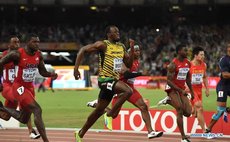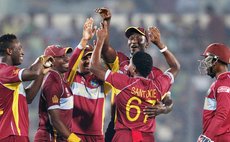Cricket on life support
Cricket had largely been associated with the very homely image of a rural sport, typified no less than by the personality of the Gloucestershire country doctor W.G Grace, known to all as the father of modern batsmanship. Before W.G Grace, batsmen were regarded as either of front foot or back foot orientation. This meant that one played strictly forward or strictly backward. This approach was not exactly unexpected, bearing in mind those were the days prior to the advent of the lawn mower in the business of pitch preparation. Wisden, the cricketers bible, has very quaintly noted that it was not uncommon for sheep to be used as grazing animals to keep the grass down before the lawn mower came on the scene. W.G. Grace was the first proponent of the technical skill of playing forward to the pitched up deliveries and playing back to the shorter pitched deliveries.
Picture, then, the scenario of the portly W.G. Grace, with necktie as a belt around his waist, controlling the bowling while batting for England or for his home county Gloucestershire and looking comfortable doing so (way back in the 1880's). Supposedly in order to inject antagonism into the scene the Australian pace bowler Ernie Jones inserts a sharp bouncer which goes through Grace's venerable beard! It is reported that Jones immediately put up his hand saying "sorry, she slipped".
That probably was the first great introduction of the bouncer as demanding a celebrity status. About forty years later the English had need to put a spoke in the wheel of the legendary Australian batsman Donald Bradman. On that tour in 1932 the England captain employed four pacers with what is known as the bodyline attack focused with short pitched deliveries directed at Bradman's body. The tactic was successful in that England won the series 4-1, but the spirit in which the matches were played evoked tremendous animosity on the part, not only of the Australian administrators but the Australian public as well. It took some time before England – Australia sports relationships emerged from the coldness of mutual distrust.
Let it be reminded that Bradman failed in that historic series, but the measure of his unparalled greatness was emphasised by the fact that his batting average for that series was as high as 69.00. Imagine that for a failure! Most batsmen would grab figures like that for a monumental success!
Since that time all countries have found need to incorporate fast bowlers with lethal bouncers as essential portion of their armoury. It has not only been a matter of putting extreme pace upfront in the grim business of the opening attack. The Australians themselves went on to apply a bold icing on the cake commonly referred to as "sledging". I have been told by some former Test batsmen the concentrated pressure cooker out there in the middle makes many batsmen feel the real presence of an assassin coming in to deliver, prompted by the chorus from the Australian slip cordon of "kill him, Tommo!" You can imagine this coming along with bowling speeds of over 85 miles per hour.
All this is intended perhaps not to kill - simply to frighten the batsman out of his wits. Alas, last week the lethal bouncer proved to be exactly that. Australian batsman Phil Hughes, 25, was cut down in the prime of his life when he attempted to hook a bouncer while batting for New South Wales, hoping to make a successful bid to regain his place in the Australian Test team. His score was on 63 and there it stayed. Hughes missed his shot, was struck on the back of the neck and died in hospital, never regaining consciousness. His death has placed international cricket under a pall, a grave reminder that could arise every time a batsman is hit by a bouncer.
We are to recall the case of Indian batsman Nari Contractor hit on the head in the West Indies, and only through means of very timely surgical operations his life was saved.
The very chilling menace of real pace was evidenced at Botanic Gardens in the mid sixties when the late Henry Elwin opening for Dominica drove Charlie Griffith back for a couple of fours from the northern end. That was not so bad. However, a mindless wit shouted from the crowd "how you like that Griffith!" The fearsome Barbadian rolled back his sleeves revealing forearms not far from the size of some men's thighs. The next two deliveries put Elwin in serious fear for his life, the ball making very near acquaintance with his nose!
Long and short of all this was its occurrence before the advent of protective helmets in cricket. These helmets are equipped with face grills and maybe invest batsmen with false sense of security against the fast stuff. Phil Hughes must have considered it safe to attempt that fateful hook, mistimed and was left exposed to penetration from behind, where the helmet offers little or no protection whatever! Such an incident will no doubt impel manufacturers of sports equipment to advance the protection factor towards far greater adequacy for all concerned.
It isn't only for batsmen the critical aspect of bodily protection needs to be more adequately sought. There definitely is case for fielders at short leg to be granted sympathetic consideration. They nowadays are equipped automatically with helmets. However, the tendency is for them to turn their backs and duck when faced with the odd errant short ball sent down by spinners. Often these fielders in turning their backs offer opportunities to be struck on the back of the neck or head in manner similar to what Phil Hughes suffered.
Only really brave, some say foolish, men post themselves at short leg. From personal experience I can confess you are likely sometimes not to see the approaching ball when it cannons off the edge of the bat. What you may see is a blur – a red ribbon, lucky if it strikes you on the chest or tummy and luckier still if you manage to clutch the rebound for a catch. Everyone will congratulate you for the marvelous catch it has been, but few are aware of the soul searching the short leg fielder must have as a constant companion, and the necessity for adequate life insurance.
Our heartfelt sympathies are with the family and friends of Phil Hughes and the Australian cricketing fraternity. We expect that first class cricket will recover from the sad death of this international cricketer. After all, the contest between batsmen and fast bowlers will remain part of the mystique of this great game. And the bouncer will always constitute a valid menace necessary as a yardstick to assist in determining the transcendent quality of eminent batsmen. I remember in the mid fifties my having to face up to the late Marcellus Thomas of the St. Mary's Academy. I was terrorized by his very sharp pace. Eventually it was my ecstatic pleasure to see Johnny (Ti Bouko) Paul coming in to bat and subjecting the bowler to a vicious pounding. He entered when I was 26 runs to my credit. Paul was out before me, scoring 64 in a blaze of aggression making the fast bowler appear quite a pathetic victim. When I was dismissed I had only moved to 28 runs! This impressed me with the poignant reality of some men's strong capability in "meeting fire with fire". Wished Phil Hughes had resorted to ducking the lifting ball instead of attempting to hook. He had such a promising future ahead of him – cut short in one freak moment.




